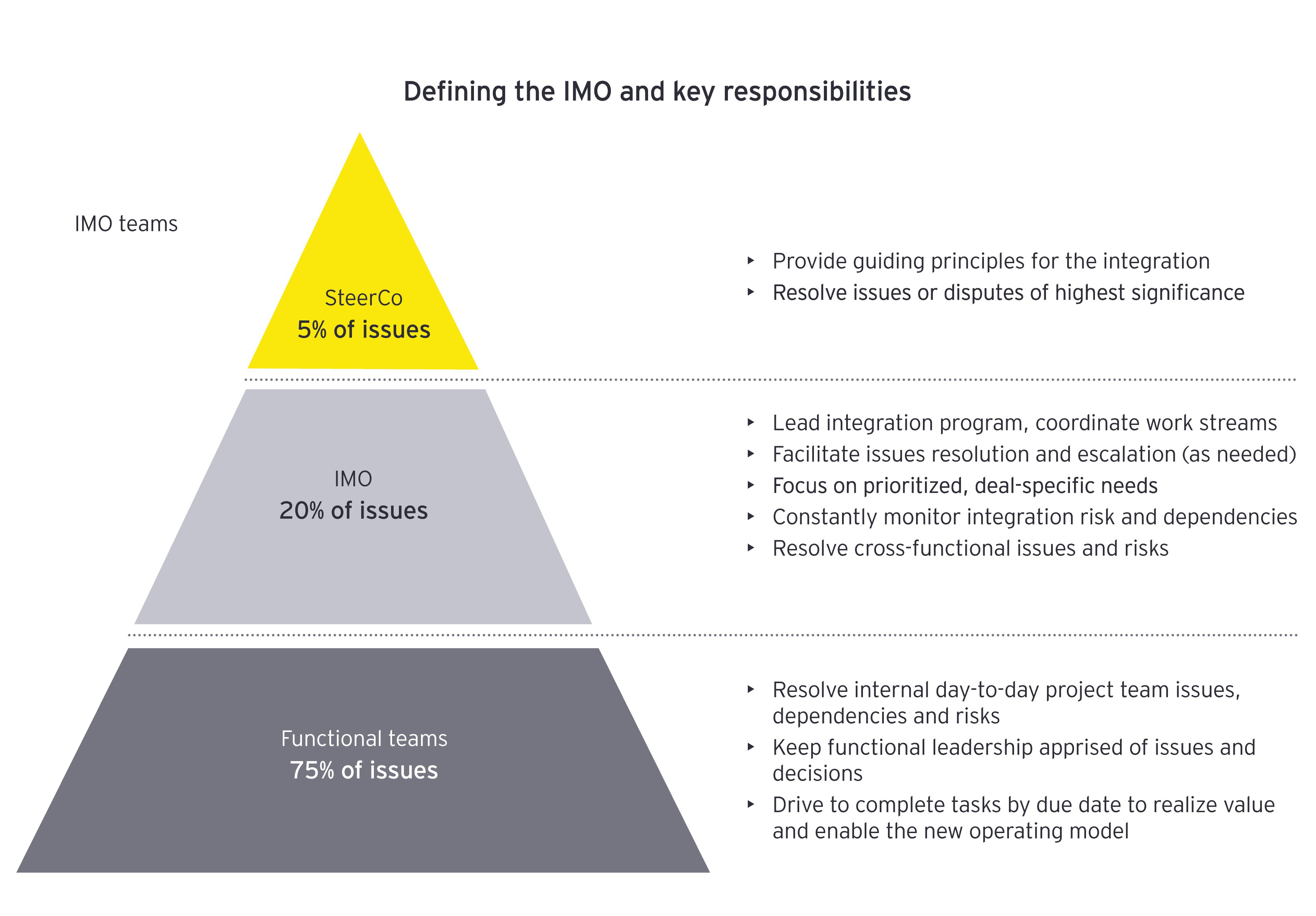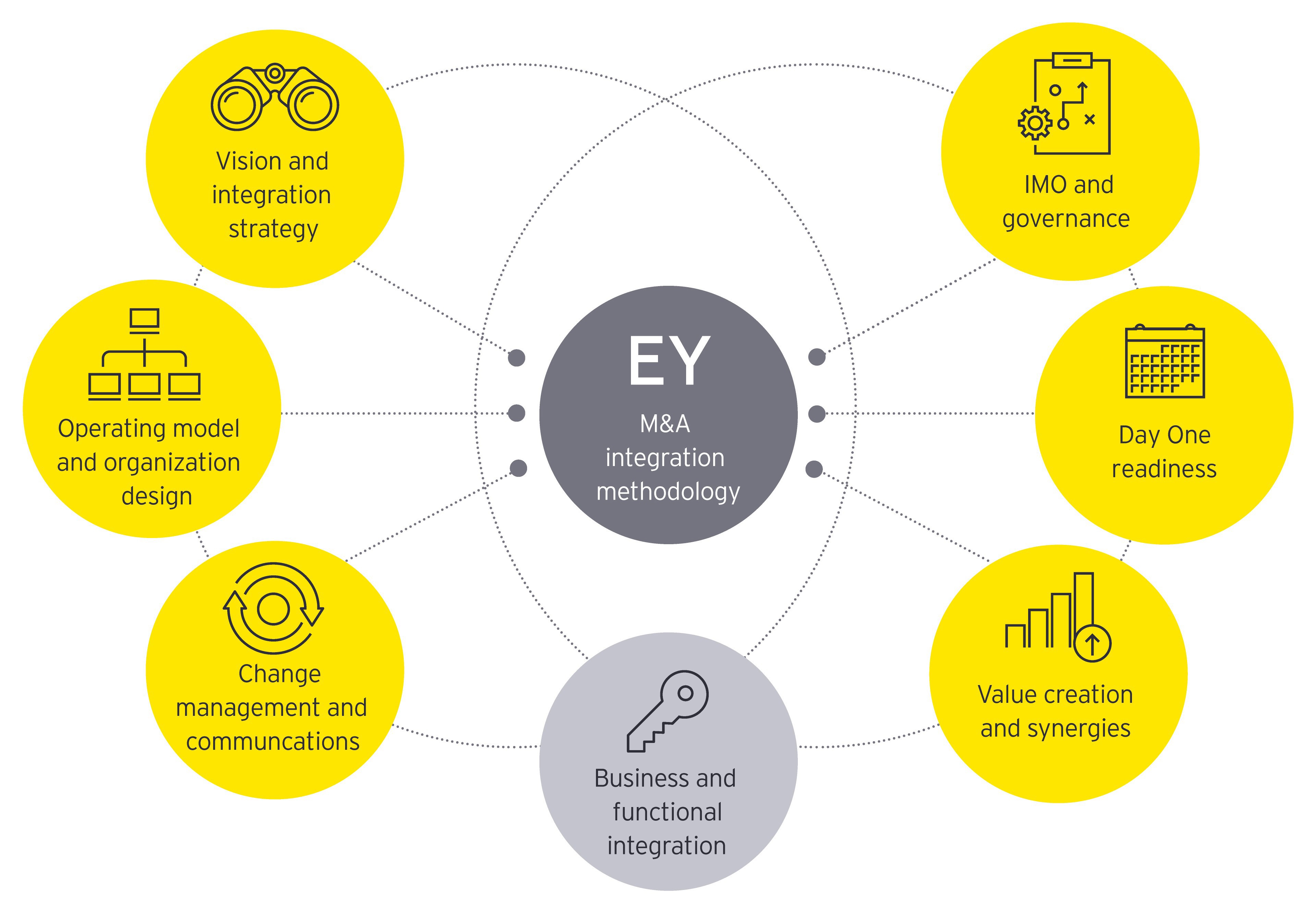2. M&A integration program and governance
Integration leaders will need to work with their general counsel, and, if necessary, outside counsel, to understand the legal guidelines of the deal, as well as regulatory considerations. While some legal risks and issues may have been raised in the diligence phase, the integration will have its own set of legal guidelines. Approvals from regulators across a number of jurisdictions might be required before a deal can close. Integration leaders should work closely with the legal team to understand these risks and requirements and to establish action plans for various situations.
It is also important to first establish confidentiality expectations with the entire integration team, as well as establish data‑sharing and communication guidelines. A significant amount of data needs to be shared between the organizations, so a clean room or other mechanism will likely be needed for sensitive information, while another mechanism can be established for nonsensitive information. If an organization does not have an effective and secure data-sharing platform, it should procure one. Confidentiality and data sharing are two key concerns in an integration. Prior to the transaction close, careful consideration should be given to prevent the sharing of competitive information and asserting influence on the target, also known as “gun-jumping,” to avoid violating antitrust laws. The integration leader will be responsible for confirming that confidentiality is not violated between companies prior to transaction close.
3. Set up the program, stand up the IMO and kick off the functional work streams
Integration leaders and the SteerCo are responsible for standing up a program with a structure to allow the work-stream leads to enable integration planning and execution within their functions, while having enough flexibility to enable the leader to adjust to the ever-changing obstacles and business imperatives of an integration. Integration leaders enable this by establishing an integration management office (IMO).
An IMO is the managing body of the integration and is responsible for simultaneously defining the integration strategy with the executives, establishing the program road map, communicating and upholding the guiding principles of the integration, and managing and resolving functional or cross-functional issues, while diligently working toward achieving the deal’s value drivers.
The integration leader must establish a strong governance structure that enables effective decision-making and creates a clear mechanism to escalate risks and issues. Based on our experience, for material transactions, a three-tiered governance structure with an executive SteerCo, IMO and functional work streams creates the appropriate level of oversight and operational efficiency.

While standing up an IMO and functional work streams, it is important to establish a weekly cadence between IMO teams to promote daily progress, escalate risks and quickly resolve problems. A reliable and consistent touch point with the functional work streams, as well as the SteerCo, allows the IMO to drive transparency, consistency and accountability throughout the integration.
To properly execute an integration, it is crucial that the integration leader, together with the SteerCo, defines the functional work streams and recruits strong work stream leaders. To do this, it is important to set the operating norms and clearly communicate how decisions will be made throughout the integration. An integration leader should look to work stream leads to provide deep functional knowledge and turn to the IMO to provide program management support and deep integration experience.
When identifying and working with the functional work stream leaders, the integration leader should consider the following:
- Work stream leads should have the functional knowledge and authority to make decisions that may have a significant impact on the business, while also taking into consideration dependencies on other functions and parts of the business.
- Integration leaders must create a strong working relationship with each of the work stream leads, as they will be responsible for executing the milestones and tasks related to the integration.
To confirm that work stream leads are adequately prepared, the integration leader and IMO should be in constant communication to discuss progress against the integration plan (e.g., status of the milestones, key risks and issues, cross-functional interdependencies).
4. Functional charters and Day One vision
Once the integration program is defined, the IMO should turn its focus to designing the newly combined company (NewCo) and determining what it will take to get there. While still upholding the guiding principles of the integration, the integration leader will guide the functional teams to determine the work streams’ charters and the critical requirements that need to be met on or shortly after Day One.
The work streams’ charters clarify the roles and responsibilities of each functional work stream, what is in scope or out of scope as part of the integration, anticipated resource requirements, key interdependencies with other functions, and an initial set of Day One milestones to close the transaction. While the work stream leads will develop the charters, the IMO will support the work streams and challenge their charters to validate that they align to the guiding principles of the deal. The IMO will also verify that each charter includes the critical requirements that need to be met on Day One to close the deal.
5. Operating model and organization design
Another key focus of the integration leader is determining how the new organization will operate by designing the operating model of the combined company. The operating model on Day One will likely look very different from the end-state model. While the functional work stream leads will develop the operating model for their function, the integration leader will be responsible for reviewing and validating alignment to the goals of the organization, including synergy targets, value drivers and guiding principles, as well as confirming cross-functional dependencies between each of the functions. The operating model should encompass the people, processes and technology dimensions of the acquirer and the target, individually as well as how they work within the combined organization.
During this phase, it’s also important to perform an operation-focused gap analysis to determine if one company has certain capabilities or processes that the other does not have or that the combined organization could benefit from long term. If this is the case, the transaction is an ideal time for business changes or transformational activities to add value to the combined organization. While this phase will take time and has a cost to execute, it will highlight the differences and raise questions on what the best long-term approach will be.
6. Business and functional integration
Once the work stream integration charters are defined and the target operating model is designed, the integration leader will coordinate the creation of a holistic integration work plan, a planning document created by each function with integration milestones, tasks, due dates, owners and interdependencies with other functions. The integration work plan articulates the who, what, when, where and how of the integration.
To determine the major milestones and tasks needed to complete the integration, it is the IMO’s responsibility to bring together functional leaders from both organizations to create a similar understanding of interdependencies, align expectations of each function and resolve competing program priorities. The starting point for this is the integration charters.
At the early phase of the integration (pre-close), the focus is entirely on closing the transaction and getting to Day One:
- Each work stream develops detailed Day One integration plans that define tasks that are required to enable a successful Day One.
- Day One readiness sessions and simulations are performed in the weeks leading up to the close of the transaction.
- Shortly before Day One, the IMO will typically start working with the work stream leads to define post-close integration plans. The focus of these plans is on achieving the vision, capturing synergies and factoring in everything that was not accomplished by Day One.
7. Drive M&A integration execution and maintain momentum
To operationalize and execute upon the strategy set forth for the combined company, integration leaders will leverage the integration work plans and the other previously discussed documents, e.g., work stream charters, operating model and organization structure. The integration work plans will establish the major milestones of the program and allow the functional leads, IMO and executives to track against the status of the program.
Dashboards and executive summaries are among the tools that can help achieve these tasks and modulate the pace of the integration, while obtaining a view of how the program is progressing. Depending on the size and speed of the transaction, these tools can vary from being simply graphs and charts managed manually, to automated, integrated solutions such as EY Capital Edge, a real-time data analytics platform that provides a full suite of capabilities required to help manage a transaction and capture deal value.
It is critical that the IMO constantly coordinates work streams and drives momentum throughout the integration. Paralysis during an integration can rapidly deplete value. Financial markets often expect early signs of value capture from the deal, and employees who are already facing heightened levels of change and uncertainty can interpret integration holdups as a sign of instability. It’s imperative for the IMO to move the organization as quickly as possible through the integration milestones to meet deadlines and capture value, while guiding the team through uncertainty, facilitating decisions and breaking down roadblocks.
Starting M&A integrations earlier
58%of executives whose deal met or exceeded expectations said they started the integration earlier, according to the EY Buy & integrate global pulse survey, 2019.
8. M&A value creation and synergies
A major requirement for deal success is delivering upon the value drivers of the transaction and hitting synergy targets, which typically takes many months to years to achieve. This can best be accomplished by building the synergy capture targets into the performance goals of the executives and by validating that the goals are embedded into the annual budgeting process vs. an offline tracking mechanism.
In addition, the executives should validate that the integration goals and targets can be turned into actionable responsibilities for the relevant work stream leads. For instance, during the target setting and planning stages of the transaction, the leader should consider setting “top down” targets that can be broken down into functional goals and developing a prioritized set of initiatives to drive tactical execution toward those targets. Then, during the tracking and reporting stages of the integration, the leader can continue to confirm that value is being captured by aligning and linking value capture reporting with overall integration management reporting. Solutions such as EY Capital Edge can facilitate synergy tracking and realization with target setting, action plans, transparency and team accountability across the entire transaction life cycle.
Driving financial rigor on an enterprise basis will enable accountability within the organization and help articulate value creation to the board and the Street.
9. Change management and communications
An M&A integration will encompass a diverse set of stakeholders. The integration leader is the SteerCo’s eyes and ears, acting as both the executives’ window into the integration and the functional leads’ primary source of access to upper management. It is essential for the IMO to confidently and tactically manage upward, knowing when to escalate issues and potential risks to the executive level, when to delegate authority down and when to make decisions as an executive proxy.
Further, the IMO will need to focus on change management and communication to motivate the core integration team and to confirm that the broader organization is supportive and ready for the pace of change. A significant number of changes could occur throughout the integration that may affect people, processes or technology. The IMO should reduce uncertainty, provide clear leadership and effectively communicate the rationale for the decisions to all stakeholders, as applicable.
Summary
A rigorous M&A integration approach can increase the speed and realization of deal success.



